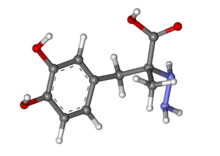Carbidopa
 |
|
 |
|
| Clinical data | |
|---|---|
| Trade names | Lodosyn |
| AHFS/Drugs.com | Monograph |
| License data | |
| Legal status | |
| Legal status | |
| Pharmacokinetic data | |
| Protein binding | 76% |
| Metabolism | decarboxylated to dopamine in extracerebral tissues |
| Biological half-life | 2 hours |
| Identifiers | |
|
|
| CAS Number |
28860-95-9 |
| PubChem (CID) | 34359 |
| IUPHAR/BPS | 5159 |
| DrugBank |
DB00190 |
| ChemSpider |
31640 |
| UNII |
KR87B45RGH |
| KEGG |
D00558 |
| ChEBI |
CHEBI:39585 |
| ChEMBL |
CHEMBL1201236 |
| ECHA InfoCard | 100.044.778 |
| Chemical and physical data | |
| Formula | C10H14N2O4 |
| Molar mass | 226.229 g/mol |
| 3D model (Jmol) | Interactive image |
| Melting point | 203 to 205 °C (397 to 401 °F) |
|
|
|
|
|
|
|
Carbidopa (Lodosyn) is a drug given to people with Parkinson's disease in order to inhibit peripheral metabolism of levodopa. This property is significant in that it allows a greater proportion of peripheral levodopa to cross the blood–brain barrier for central nervous system effect.
Carbidopa inhibits aromatic-L-amino-acid decarboxylase (DOPA Decarboxylase or DDC), an enzyme important in the biosynthesis of L-tryptophan to serotonin and in the biosynthesis of L-DOPA to dopamine (DA). DDC exists both outside of (body periphery) and within the confines of the blood–brain barrier.
Carbidopa is used in the treatment of, among other diseases, Parkinson's disease (PD), a condition characterized by death of dopaminergic neurons in the substantia nigra. Increased dopamine available may increase the effectiveness of the remaining neurons and alleviate symptoms for a time. The pharmacologic objective is to get an exogenous dopamine-precursor known as levodopa/L-DOPA into the dopamine-deficient brains of PD patients. Levodopa/L-DOPA can cross the blood–brain barrier, but dopamine cannot. The use of carbidopa seems counter-intuitive in Parkinson's disease (PD) in that it prevents DDC conversion of levodopa/L-DOPA to dopamine. However, exogenously provided, levadopa/L-DOPA gets metabolized peripherally to its active metabolite dopamine before reaching the blood–brain barrier. Therefore, the PD brain, which is deficient in dopamine, will not receive as much of its prodrug precursor levodopa/L-DOPA due to peripheral DDC breakdown. However, carbidopa can decrease peripheral DDC conversion of levodopa/L-DOPA before it crosses the blood–brain barrier. Carbidopa acts as a peripheral DDC inhibitor, as carbidopa, itself, cannot cross the blood–brain barrier. In other words, carbidopa has no effect on brain DDC conversion of levodopa/L-DOPA to dopamine. Ultimately, a greater proportion of the exogenously provided levodopa/L-DOPA reaches the brain. Commercially, carbidopa/levodopa combinations are available in the treatment of central dopamine deficiencies.
...
Wikipedia
